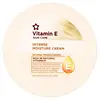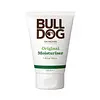What's inside
What's inside
 Key Ingredients
Key Ingredients

No key ingredients
 Benefits
Benefits

 Concerns
Concerns

 Ingredients Side-by-side
Ingredients Side-by-side

Water
Skin ConditioningGlycerin
HumectantButyrospermum Parkii Butter
Skin ConditioningDimethicone
EmollientCetearyl Alcohol
EmollientCetyl Alcohol
EmollientCeteareth-20
CleansingPropylene Glycol
HumectantSodium Polyacrylate
AbsorbentTocopheryl Acetate
AntioxidantTocopherol
AntioxidantAlcohol Denat.
AntimicrobialPEG-35 Castor Oil
EmulsifyingPolysorbate 20
EmulsifyingAesculus Hippocastanum Seed Extract
Skin ConditioningRetinyl Palmitate
Skin ConditioningInositol
HumectantCalcium Pantothenate
Linoleic Acid
CleansingBiotin
AntiseborrhoeicParfum
MaskingPentylene Glycol
Skin ConditioningSodium Lactate
BufferingLactic Acid
BufferingSerine
MaskingUrea
BufferingSorbitol
HumectantSodium Chloride
MaskingAllantoin
Skin ConditioningCarbomer
Emulsion StabilisingPotassium Hydroxide
BufferingPhenoxyethanol
PreservativeEthylhexylglycerin
Skin ConditioningCoumarin
PerfumingLinalool
PerfumingButylphenyl Methylpropional
PerfumingAlpha-Isomethyl Ionone
PerfumingDisodium EDTA
Water, Glycerin, Butyrospermum Parkii Butter, Dimethicone, Cetearyl Alcohol, Cetyl Alcohol, Ceteareth-20, Propylene Glycol, Sodium Polyacrylate, Tocopheryl Acetate, Tocopherol, Alcohol Denat., PEG-35 Castor Oil, Polysorbate 20, Aesculus Hippocastanum Seed Extract, Retinyl Palmitate, Inositol, Calcium Pantothenate, Linoleic Acid, Biotin, Parfum, Pentylene Glycol, Sodium Lactate, Lactic Acid, Serine, Urea, Sorbitol, Sodium Chloride, Allantoin, Carbomer, Potassium Hydroxide, Phenoxyethanol, Ethylhexylglycerin, Coumarin, Linalool, Butylphenyl Methylpropional, Alpha-Isomethyl Ionone, Disodium EDTA
Water
Skin ConditioningAloe Barbadensis Leaf Juice
Skin ConditioningEthylhexyl Palmitate
EmollientCaprylic/Capric Triglyceride
MaskingGlycerin
HumectantSorbitan Stearate
EmulsifyingSodium Polyacrylate
AbsorbentPentaerythrityl Distearate
EmulsifyingPhenoxyethanol
PreservativeSodium Stearoyl Glutamate
CleansingParfum
MaskingBenzoic Acid
MaskingCarbomer
Emulsion StabilisingDehydroacetic Acid
PreservativeLimonene
PerfumingLinalool
PerfumingCitronellol
PerfumingGeraniol
PerfumingCitral
PerfumingCitric Acid
BufferingSodium Hydroxide
BufferingWater, Aloe Barbadensis Leaf Juice, Ethylhexyl Palmitate, Caprylic/Capric Triglyceride, Glycerin, Sorbitan Stearate, Sodium Polyacrylate, Pentaerythrityl Distearate, Phenoxyethanol, Sodium Stearoyl Glutamate, Parfum, Benzoic Acid, Carbomer, Dehydroacetic Acid, Limonene, Linalool, Citronellol, Geraniol, Citral, Citric Acid, Sodium Hydroxide
Ingredients Explained
These ingredients are found in both products.
Ingredients higher up in an ingredient list are typically present in a larger amount.
Carbomer is a polymer of acrylic acid. Its main role is to create a gel consistency.
A high amount of carbomer can cause pilling or balling up of products. Don't worry, most products contain 1% or less of carbomer.
Glycerin is already naturally found in your skin. It helps moisturize and protect your skin.
A study from 2016 found glycerin to be more effective as a humectant than AHAs and hyaluronic acid.
As a humectant, it helps the skin stay hydrated by pulling moisture to your skin. The low molecular weight of glycerin allows it to pull moisture into the deeper layers of your skin.
Hydrated skin improves your skin barrier; Your skin barrier helps protect against irritants and bacteria.
Glycerin has also been found to have antimicrobial and antiviral properties. Due to these properties, glycerin is often used in wound and burn treatments.
In cosmetics, glycerin is usually derived from plants such as soybean or palm. However, it can also be sourced from animals, such as tallow or animal fat.
This ingredient is organic, colorless, odorless, and non-toxic.
Glycerin is the name for this ingredient in American English. British English uses Glycerol/Glycerine.
Learn more about GlycerinLinalool is a fragrance and helps add scent to products. It's derived from common plants such as cinnamon, mint, citrus, and lavender.
Like Limonene, this ingredient oxidizes when exposed to air. Oxidized linalool can cause allergies and skin sensitivity.
This ingredient has a scent that is floral, spicy tropical, and citrus-like.
Learn more about LinaloolParfum is a catch-all term for an ingredient or more that is used to give a scent to products.
Also called "fragrance", this ingredient can be a blend of hundreds of chemicals or plant oils. This means every product with "fragrance" or "parfum" in the ingredients list is a different mixture.
For instance, Habanolide is a proprietary trade name for a specific aroma chemical. When used as a fragrance ingredient in cosmetics, most aroma chemicals fall under the broad labeling category of “FRAGRANCE” or “PARFUM” according to EU and US regulations.
The term 'parfum' or 'fragrance' is not regulated in many countries. In many cases, it is up to the brand to define this term.
For instance, many brands choose to label themselves as "fragrance-free" because they are not using synthetic fragrances. However, their products may still contain ingredients such as essential oils that are considered a fragrance by INCI standards.
One example is Calendula flower extract. Calendula is an essential oil that still imparts a scent or 'fragrance'.
Depending on the blend, the ingredients in the mixture can cause allergies and sensitivities on the skin. Some ingredients that are known EU allergens include linalool and citronellol.
Parfum can also be used to mask or cover an unpleasant scent.
The bottom line is: not all fragrances/parfum/ingredients are created equally. If you are worried about fragrances, we recommend taking a closer look at an ingredient. And of course, we always recommend speaking with a professional.
Learn more about ParfumPhenoxyethanol is a preservative that has germicide, antimicrobial, and aromatic properties. Studies show that phenoxyethanol can prevent microbial growth. By itself, it has a scent that is similar to that of a rose.
It's often used in formulations along with Caprylyl Glycol to preserve the shelf life of products.
Sodium Polyacrylate is the sodium salt of polyacrylic acid. It is used as an absorber, emollient, and stabilizer.
This ingredient is a super-absorbent polymer - meaning it can absorb 100 to 1000 times its mass in water. As an emollient, Sodium Polyacrylate helps soften and soothe skin. Emollients work by creating a barrier to trap moisture in. This helps keep your skin hydrated.
Water. It's the most common cosmetic ingredient of all. You'll usually see it at the top of ingredient lists, meaning that it makes up the largest part of the product.
So why is it so popular? Water most often acts as a solvent - this means that it helps dissolve other ingredients into the formulation.
You'll also recognize water as that liquid we all need to stay alive. If you see this, drink a glass of water. Stay hydrated!
Learn more about Water